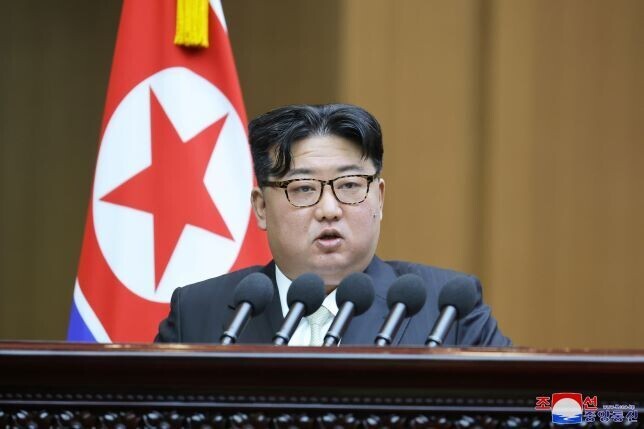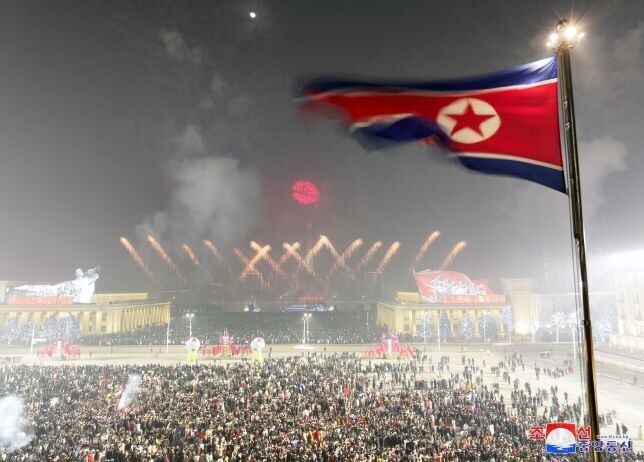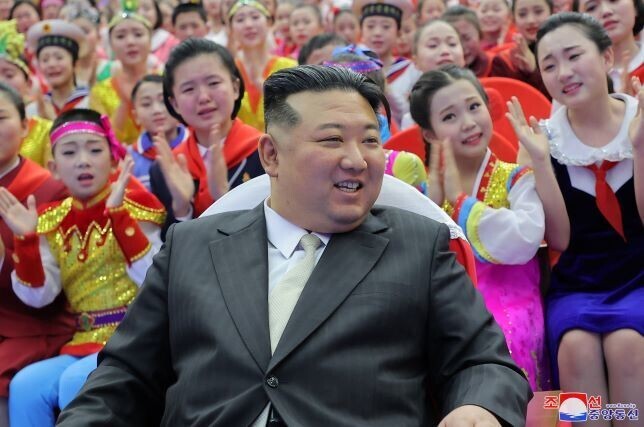hankyoreh
Links to other country sites 다른 나라 사이트 링크
[News analysis] 5 takeaways from Kim Jong-un’s declaration of inter-Korean relations as “hostile”

North Korean leader Kim Jong-un recently made the shocking declaration that inter-Korean relations are the relations “between two states hostile to each other” and defined South Korea as the North’s “invariable principal enemy.” That poses a number of questions: What does Kim’s new line have in common with the unification line held by his grandfather Kim Il-sung and his father Kim Jong-il, and how are they different? What is the meaning of this declaration? Why did he make it now? What is his objective? And who benefits from this choice?
Rupture and continuity: Moving inter-Korean relations from dual-track to single-track
In some ways, Kim’s new line represents a rupture with his grandfather and father’s perspective on inter-Korean relations, but in others, it’s a continuation of that.
Since the foundation of the Democratic People’s Republic of Korea in 1948, North Korea has advanced “unification of the fatherland” as one of the chief goals of the state, under the motto, “Korea is one.” But Kim said during a policy speech at the 10th Session of the 14th Supreme People’s Assembly on Monday that North Korea should “completely eliminate such concepts as ‘reunification,’ ‘reconciliation’ and ‘fellow countrymen’ from the national history of our Republic,” as well as from North Korea’s constitution.
Those remarks sound like a departure from the Kim Il-sung and Kim Jong-il line on unification. But once we scratch the surface, we see that Kim retains the goals of building a socialist Korea and blocking “unification by absorption,” even while dispensing with the pro forma unification policy held by the earlier leaders.
South and North Korea’s simultaneous and separate admission to the UN on Sept. 17, 1991, confirmed that the two were separate sovereign states under international law. So on Dec. 13, of that year, the two sides adopted the Agreement on Reconciliation, Non-Aggression, and Exchanges and Cooperation between South and North Korea, also known as the South-North Basic Agreement, in which they recognized theirs as “a special interim relationship stemming from the process towards reunification” rather than “a relationship between states.”
But now North Korea is pursuing the coexistence of “two Koreas” as a way to avoid the “unification by absorption” it so fears.

When Kim told the Supreme People’s Assembly that he recognizes two states coexisting on the Korean Peninsula, he was basically adopting a one-track strategy in place of the two-track strategy of Kim Il-sung and Kim Jong-il, who ostensibly advocated “one Korea” but quietly accepted “two Koreas.” That amounts to a dismantling of the arrangement brokered by the South-North Basic Agreement and a full-throated acceptance of the “two Koreas” narrative, symbolized by their separate admission to the UN.
“Going forward, [Kim] means to deal with South Korea the way he deals with Japan,” — that is, as a hostile state — said a veteran researcher who was born in North Korea.
Is Kim scrapping all inter-Korean agreements?
The principle of “one Korea” during the reigns of Kim Il-sung and Kim Jong-il was merely a ruling ideology, and not a governing principle of their foreign strategy. Whereas China has unconditionally cut diplomatic ties with countries that maintain diplomatic relations with Taiwan under the “one China” principle, 156 of the 159 countries that have diplomatic relations with North Korea also have such ties with the South.
The reality is that North Korea has long acknowledged “two Koreas” on a de facto basis. In 1973 — the year after South and North Korea concluded the July 4 South-North Joint Statement, the first written agreement between them — North Korea joined the World Health Organization, the UN Conference on Trade and Development, and the Inter-Parliamentary Union, organizations of which South Korea was already a member. In so doing, North Korea accepted the reality of “two Koreas.”
After taking power in 2012, Kim himself revealed his desire to reset inter-Korean relations as a relationship between states by setting up “Pyongyang Time” on Aug. 15, 2015, which split South and North Korea into separate time zones. (This was later reversed in 2018 during a period of inter-Korean dialogue.) Kim has also ordered the deletion of the three principles of national reunification (independence, peaceful reunification and great national unity) from the constitution 52 years after those principles were endorsed by his grandfather Kim Il-sung in the July 4 South-North Joint Statement. That more or less amounts to neutralizing all previous inter-Korean agreements.
Did Yoon’s criticism of North Korea as “principal enemy” gave the North the perfect excuse?
That leads to the question of why Kim has chosen now as the time to adopt his new line. Kim’s plan to bury Kim Il-sung and Kim Jong-il’s ethnonationalist banner of “Korea is one” seeks a full-fledged reconstitution of North Korea’s ruling ideology and state identity, which is bound to be a major political liability.
Kim may have thought that South Korean President Yoon Suk-yeol’s personal denunciation of the North as the South’s “principal enemy” may have been the perfect time to persuade the North Korean public that South Korea is a completely separate country and the most hostile state to the North.
After revising the constitution this year and then amending the charter of the Workers’ Party of Korea in its Ninth Congress in 2026 to completely remove “unification” from North Korea’s legal code, North Korea might seek to establish a new “relationship between states” with the administration that will come to power in South Korea in 2027.
Projections that the US presidential election in November may well be won by Donald Trump, who has personally met Kim three times, may also have influenced Kim’s choice of the timeframe for announcing his new policy line.
Does Kim hope to become the autocrat of a “normal state”?
What’s the goal of Kim’s new course? Following in the footsteps of his grandfather Kim Il-sung, the “father of socialist Korea,” and his father Kim Jong-il, who “safeguarded with honour the achievements of socialism” in the face of the “collapse of the world socialist system,” the younger Kim’s ultimate aim appears to be establishing a distinctive leadership style as Kim Il-sung’s grandson, in which role he’s expected to bring to fruition “Juche” Korea’s autonomy, survival and development.

Kim seems to want to believe that if he erects a security bulwark in the form of a nuclear deterrent and works on building a self-sufficient economy, “full-scale development of socialism with Korean characteristics” will be possible.
“Kim Jong-un’s dream is being the autocrat of a normal state,” remarked one researcher of North Korea.
The paradox of trashing the ethnonationalism/unification line
Nevertheless, the vast majority of experts think that sustainable development of the North Korean economy isn’t possible without the influx of external resources and technology through dramatic improvement of foreign relations.
Another observation is that Kim’s closed-door policy toward South Korea may ultimately prove to be a strategic blunder, since it means North Korea is willingly forgoing all the credit it has built up in the debate over unification and ethnonationalism with its motto “Korea is one.”
In an article at 38 North, a website providing analysis on Korean Peninsula affairs, Rüdiger Frank compared Kim’s new policy to “a gift to South Korea.”
“Ironically, the clear winner of this new policy seems to be South Korea, particularly its conservative forces,” wrote Frank, a professor at the University of Vienna who was born in East Germany and studied at Kim Il Sung University.
According to Frank, North Korea’s abandonment of its unification policy would leave South Korea as the “only Korea” advocating peaceful unification on the Korean Peninsula, and North Korea’s hardline stance toward South Korea, when accompanied by military action, will only strengthen the position of South Korea’s conservatives.
By Lee Je-hun, senior staff writer
Please direct questions or comments to [english@hani.co.kr]

Editorial・opinion
![[Guest essay] Preventing Korean Peninsula from becoming front line of new cold war [Guest essay] Preventing Korean Peninsula from becoming front line of new cold war](https://flexible.img.hani.co.kr/flexible/normal/500/300/imgdb/original/2024/0507/7217150679227807.jpg) [Guest essay] Preventing Korean Peninsula from becoming front line of new cold war
[Guest essay] Preventing Korean Peninsula from becoming front line of new cold war![[Column] The state is back — but is it in business? [Column] The state is back — but is it in business?](https://flexible.img.hani.co.kr/flexible/normal/500/300/imgdb/original/2024/0506/8217149564092725.jpg) [Column] The state is back — but is it in business?
[Column] The state is back — but is it in business?- [Column] Life on our Trisolaris
- [Editorial] Penalties for airing allegations against Korea’s first lady endanger free press
- [Editorial] Yoon must halt procurement of SM-3 interceptor missiles
- [Guest essay] Maybe Korea’s rapid population decline is an opportunity, not a crisis
- [Column] Can Yoon steer diplomacy with Russia, China back on track?
- [Column] Season 2 of special prosecutor probe may be coming to Korea soon
- [Column] Park Geun-hye déjà vu in Yoon Suk-yeol
- [Editorial] New weight of N. Korea’s nuclear threats makes dialogue all the more urgent
Most viewed articles
- 1Behind-the-times gender change regulations leave trans Koreans in the lurch
- 2Family that exposed military cover-up of loved one’s death reflect on Marine’s death
- 3Yoon’s revival of civil affairs senior secretary criticized as shield against judicial scrutiny
- 4Japan says its directives were aimed at increasing Line’s security, not pushing Naver buyout
- 5Unexpected rate of AI development requires timely discussion of side effects
- 6[Guest essay] Preventing Korean Peninsula from becoming front line of new cold war
- 7Marines who survived flood that killed colleague urge president to OK special counsel probe
- 8[Guest essay] Maybe Korea’s rapid population decline is an opportunity, not a crisis
- 9S. Korean first lady likely to face questioning by prosecutors over Dior handbag scandal
- 10Is Japan about to snatch control of Line messenger from Korea’s Naver?